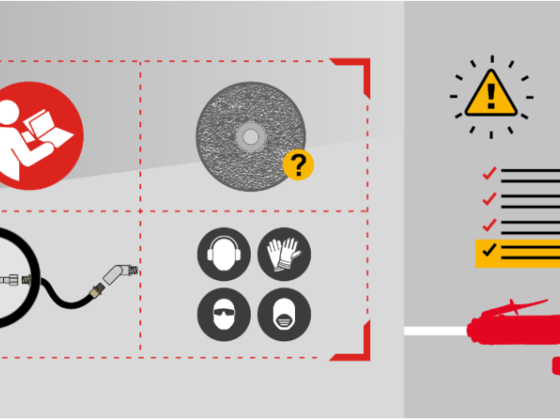Removal tools such as grinders and sanders can pose significant danger if not used responsibly
But how do you limit the risks when using tools such as pneumatic grinders?
Read the user manual and safety instructions…
For both the tool and the abrasive.
They are in the box for a reason – to help you!
Check the air line set up
Correct air line installation is critical for using pneumatic tools safely. Here are some key points:
– To secure the correct speed on your tool, you need to regulate the air pressure to 90 psi (6.3 bars).
– Use an FRL to control pressure, lubricate and clean the air.
– Make sure you have a good, tight connection between the airline and the tool’s inlet. Use TEFLON tape or similar to help achieve this.
Use the right abrasives
1. Speed
Each abrasive disc can only cope with a certain peripheral speed and has a designated maximum operating speed (MOS). This is labelled directly on the abrasive or on the packaging and expressed in revolutions per minute (rpm). Compare the abrasive’s MOS with the tool’s speed and never exceed the maximum speed allowed for the abrasive.
2. Size
Use the right size abrasive for your tool. If the disc is too large:
– You will not be able to attach the disc correctly or use the proper guard for this abrasive.
– You risk the speed of the grinder exceeding the abrasive’s MOS, which could have the divesting consequences mentioned above.
Let’s put it simply: large abrasives are not made for small grinders.
3. Operation
We often see an abrasive being used for an application it isn’t built for. It may sound basic, but always use an abrasive designed for the job: i.e. only use a cutting wheel for cutting and a grinding wheel for grinding.
4. Storage
Abrasives will degrade over time if not stored appropriately and they also have a use-by date. Our advice: Throw away abrasives that have not been stored correctly or that have expired.
Follow the pneumatic grinder’s operating recommendations
All is explained in the video:
Key points:
– Consider the environment. Ventilate the area as much as possible and wear appropriate PPE (personal protective equipment) for the job, including gloves, safety glasses, hearing protection, steel toes and dust masks.
– Use the safety guard and ensure it is well positioned to provide maximum protection – this has been designed for a very good reason. Do NOT remove or alter the guard!
– Check the workpiece is secure and well clamped.
– Make sure that you have a stable operating position. Don’t stand on a slippery or unstable floor!
– Run the tool at free speed for 30 seconds in a safe enclosed area to check it is operating as expected. If there are any abnormal vibrations, stop the tool immediately: it requires maintenance.
– Never apply excessive force during work.
– After switching off the machine, ensure that the abrasive has come to rest before putting down the tool.
Safe grinding!
Interested in CP Chicago Pneumatic? Find out more by subscribing to their mailing list!


